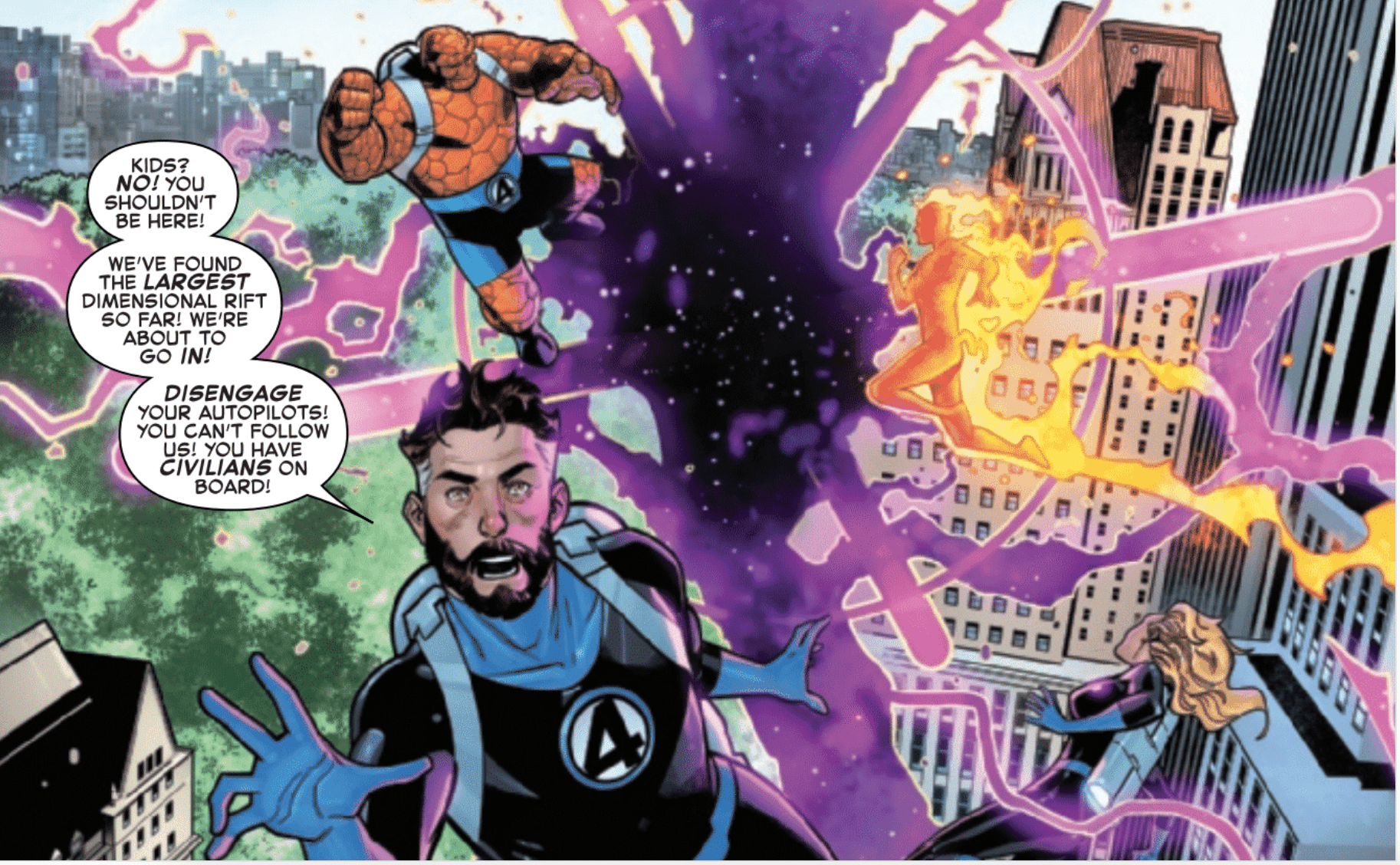In Fantastic Four #11, a new adversary threatens to vanquish the heroes once and for all. The team must face the menacing threat of… a driving test. The Fantastic Four has stared down Doctor Doom without blinking. They’ve defeated Galactus. They’ve dealt with Mole Man and Namor, too. But could be this foe be the one that takes the First Family down?

Writer: Dan Slott
Artists: Paco Medina, Kevin Libranda, Paolo Villanelli & Juanan Ramírez
Color artist: Jesus Aburtov
Letterer: VC’s Joe Caramagna
STORY
Throughout writer Dan Slott’s run on Fantastic Four, Franklin Richards has been a tough pill to swallow. Slott had Franklin and his sister Valeria return to the Marvel Universe as teenagers early in the series; since then, both Richards children have been prone to episodes of A.T.S.: Annoying Teenager Syndrome. Franklin, in particular, has consistently been a jerk. Last issue, he was especially obnoxious and he bragged about his godlike powers. This previous installment ended with some hints of progress but, here, Franklin is back to where he started.
Thankfully, Johnny Storm corrects one of the mistakes the family previously made when dealing with Franklin’s attitude; Johnny tries to talk to the troubled teen. (Last issue, nobody reached out to him.) Of course, Franklin blows him off but it’s the thought that counts, right? Plus, Franklin isn’t as insufferable this go-around; in fact, he uses his Annoying Teenager Syndrome to help save the day.

“Your kid used his disgruntled teen powers for good,” Johnny Storm succinctly tells Reed and Sue Richards. That’s right; when Gargantua (an unimpressive villain of the week in limited action) threatens to violently replace the main Marvel Universe with the Microverse, Franklin simply shows her some pictures of Earth on his phone and trashes the world Gargantua covets. Compared to the spectacular Microverse, Franklin says the main dimension “sucks” and asks the villain, “why would you trade one second of this–for the world I’m gonna be stuck with for the rest of my stupid life?” Under Slott’s guidance, Franklin remains a somewhat static character and it’s getting harder to use the virtue of patience as an excuse for this lack of progress. Still, at least for now, let’s appreciate that Slott found a way to make Franklin’s off-putting attitude legitimately useful.

In the traditional sense, Gargantua is the villain in this issue. But when Franklin and Valeria have to take a driving test, it’s clear what the real antagonist is. Harriet Underhill and Tobias Cobb of the Department of Extranormal Motor Vehicles invade Yancy Street and tell the Fantastic Four that the Richards siblings won’t be allowed to drive the team’s amazing vehicles until they pass the test. To prepare the siblings for the exam, Johnny and Ben Grimm try to teach Franklin and Valeria how to drive in a montage-like sequence that’d fit perfectly in an ’80s-movie. (Is that “Eye of the Tiger” in the background?)
Slott sets up a fairly predictable outcome and turns it on its head. Valeria wipes the floor with Franklin in these training sessions. But, when the duo gets roped into Gargantua’s battle with the Fantastic Four, Valeria fails to practice safe driving. “Talking on a communicator, operating complex apps and performing scientific experiments…while piloting a vehicle?,” Underhill asks the team. “Why, that’s worse than driving while texting!” By comparison, Franklin pulls over and, before he enters the fray, he ensures that his passenger is safe. As a result, Franklin passed the test while Valeria failed. Even if he loses his powers, as Slott continues to suggest, Franklin has a guaranteed role on the team as its wheelman.
ART

Slott’s run on Fantastic Four is eleven issues deep and, more often than not, the writing and the art combine to give the reader exactly what you’d expect in a story featuring the team. This time around, the team of Paco Medina, Kevin Libranda, Paolo Villanelli & Juanan Ramírez and color artist Jesus Aburtov make the most of Slott’s script and its lackluster villain (Gargantua.)
Sometimes, it’s the little things that make the difference. Using vibrant, electric blues and purples, the art team makes the Microverse come alive. The bright lightning-like bursts of energy make the reader feel like Gargantua’s dimension is actually expanding into the main Marvel Universe; the artists successfully convey the sense of motion.

Similarly, when the Fantastic Four investigates some subspace tears, the art team makes the scene feel like a classic story featuring Marvel’s First Family. The dimensional rift isn’t as menacing as a black hole but, using dynamic, ominous purple tendrils, the rift still seems dangerous. In a Fantastic Four story, every time the art complements the science fiction elements of the plot, it has to be considered a success.
As with other issues of Slott’s run, this installment focuses on the Fantastic Four’s family dynamic first and foremost. As long as Slott continues to do so in an enjoyable way, fans can consider the writer’s take on the First Family as a solid series that explores common domestic issues.
What’d you think of Fantastic Four #11? How do you feel about Franklin Richards’ attitude?

